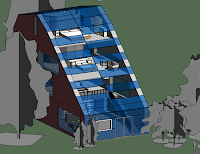2011/5/24 CC training tour
PART 1: Morning tour 10:00—12:20 ( DDVAV) John and iraj
That morning, we visited the DDVAV system in Evans Library.
We went to the mechanic rooms in library on that day. The first mechanic room we went to is located in the basement of Evens library. We discussed the function of VFD. John gave us the example that when VFD is 60HZ it can make the motor supply 60 horse power. If the VFD keeps 60 Hz, Whether it can make the motor to supply 50 house power energy. It cannot, because the frequency of VFD will go down due to reducing the load. That means if the motor supplies 50 horse power energy, the frequency of VFD should below 60 Hz. That is the reason why we use VFD because we use it to save energy.
Then we went to see the chiller of Evens library. There are two types of chillers, one is the water cold chiller, and the other one is the air cold chiller. For Evens, they use air cold chiller. Air-cooled chillers use the mechanical refrigeration cycle to produce chilled water. Air-cooled chiller is more economic than water-cooled chiller. The cooling tower works like air-cooled chiller. So when the OA temperature is low, the chilled water can be directly used for cooling the coil, which can be energy efficient In addition, if the HVAC system has economizer, the outside air can be used for cooling.
At last, we went to the mechanic room in the third floor of Evens Library. At there I understand the different between the electrical valve and the pneumatic valve. And we had the chance to see how DDC worked. Then translator changes the analog signals, which is collected by the sensors, into digital signals. Then, these digital signals will be sent to controller for future control.
PART 2: Afternoon tour 1:30—4:30 Iraj
In the afternoon, we visited the SDVAV system first. The diffusers there are interesting, because they are located on the same duct as shown below:
The supply air goes like the arrow implied. At first I wonder if there are so many diffusers on that duct the pressure will go down after each diffuser. Nevertheless, as we can see, when add more diffusers on this duct, the dimension of it will be reduced. In this method, the pressure will be kept at the same level.
After the short tour for this visit, we had the chance to see DDVAV system with economizer. The model of this system is as following:
When in the economizer condition, the damper between return duct and supply duct will be closed, the damper of relief duct will be opened 100% and the damper of outside air duct will be opened 100%. While when the building don’t need to use economizer, the damper between return air duct and supply air duct will be opened, the relief and outside air duct will be opened according the need of the system.
Then we saw different sensors for HVAC system. For example, the difference between pressure sensor and temperature sensor is that the pressure sensor always has the isolation valve. Moreover, we learned how to install the different sensor for different purposes. For example, if we want to measure pressure after fan, we need install a sensor before the fan and a sensor after the fan, and then the difference between the two sensors is the pressure.
The flow monitor needs to be cleaned on time because there are many holes on that monitor. If now clean it, it will not work anymore.
The last HVAC system we saw is the one located in Wasinbaker. There we focus on the freezestat.
The freezestat is used to protect coils.
The location of the freezestat we saw has something wrong with it. The Model looks like following:













